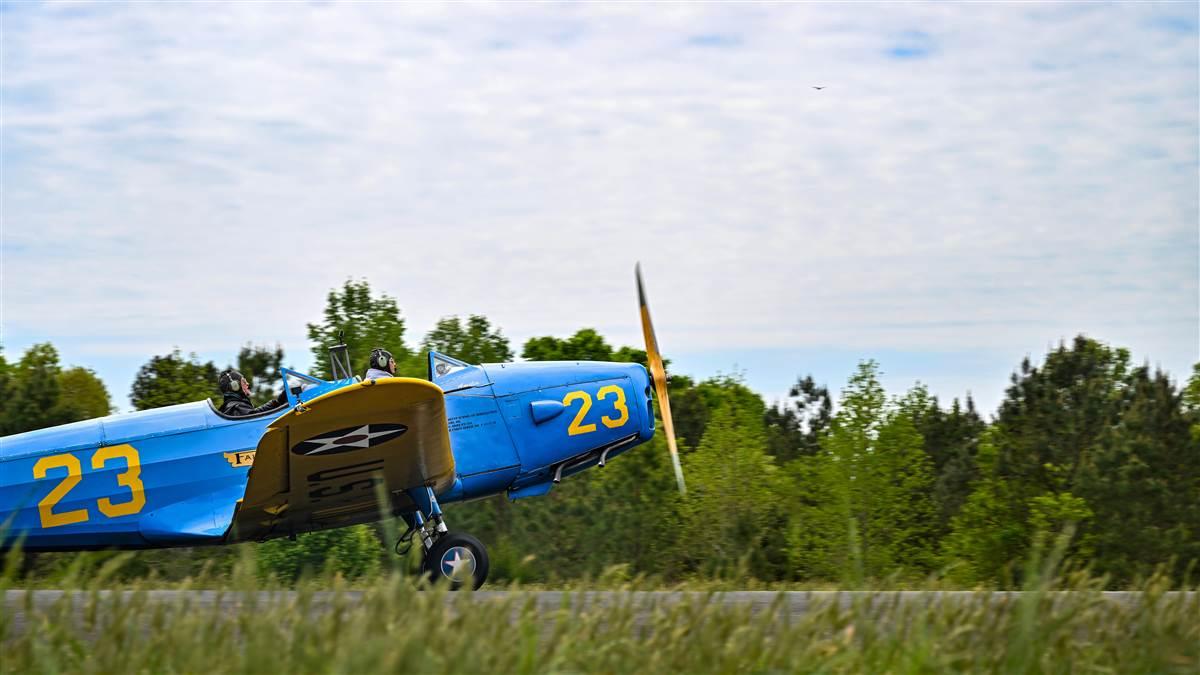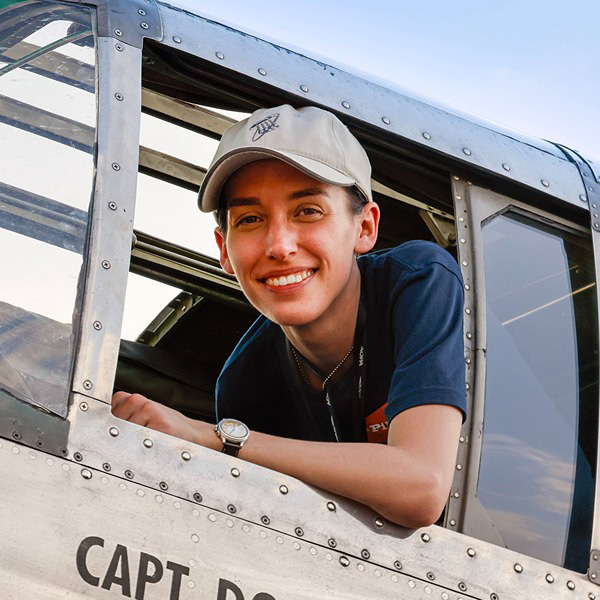Endangered species
Rare pilot-maker still has lessons to teach

An aircraft that is demanding yet friendly is the paradox of the Fairchild PT–19, colorful in every sense of the word. Once the primary training aircraft for many American pilots in World War II, one of these rare birds is holding onto its place in the aviation ecosystem thanks to the devotion of its owner and pilot, Michael Kuhnert.
An introduction to this PT–19 starts with entering a little office on Hummel Field (W75) in Topping, Virginia, where the Rappahannock River enters the western Chesapeake Bay. Kuhnert, owner and operator of Bay Aviation, is a legend in the community, with a jovial wit, huge smile, and contagious enthusiasm for life and flying. Born in West Berlin, Kuhnert grew up near the Berlin-Tempelhof Airport admiring aircraft and was a yacht captain roaming Europe, the Caribbean, and Atlantic until the mid-1990s. After moving to the United States and eventually becoming a charter pilot, flight instructor, and warbird pilot, he started Bay Aviation as a one-aircraft flight school in 2007. Now he has a Cessna 172, a Super Decathlon, and the PT–19, in all of which he offers rides and flight instruction.
“Today is all about you,” Kuhnert tells his students, but don’t take that as flattery. The day will be about the student discovering previously unknown deficiencies in their flying habits and correcting them closely. Kuhnert is also a workout coach, so his flight lessons feel a lot like a strenuous exercise session, pushing to improve while still having fun and keeping a positive attitude.
After ground school, Q&A, and telling a few stories, Kuhnert dons his black leather bomber jacket, silk scarf, and aviators and leads the way out to the gleaming PT–19 perched in the grass in front of the road, with a banner advertising “RIDES” hanging from the propeller.
‘Cradle of Heroes’
Along with the venerable Boeing Stearman, the Fairchild PT–19 Cornell was a critical part of the primary training (PT) program for the U.S. Army Air Corps in the 1940s, where it earned the nickname “cradle of heroes” for its starting role in the journey of pilot cadets destined for combat. But where Stearmans found a commercial niche after the war in crop dusters because of their large useful load, ease of outfitting with bigger engines, and being comparatively easy to fly, the PT–19s were good for little else than flight schools and personal flying, selling so cheaply postwar that they were viewed as mostly disposable.
“Sitting outside as cheap airplanes tend to do, it didn’t do very well for longevity,” says Kuhnert. “Basically, by the 1960s the whole country was littered with decrepit and rotted-away PT–19s, and only in the seventies people started to restore those. As of this year there are only 98 flying worldwide.” But the model’s value as an army trainer in its heyday was undisputed.
“Being a primary trainer, it had to be two things: sturdy and forgiving,” Kuhnert says. Much of the forgiveness is provided by the landing gear with a very wide stance and long gear travel of about 10 inches from loaded sitting position to extended while in the air, helping even the newest pilots make gentle touchdowns.
“It was the first modern primary trainer,” Kuhnert explains. “Fabric with wooden wings and steel tubing fuselage....Extensively wind tunnel tested, very benign stall and spin characteristics, split flaps, higher landing speed and higher wing loading—much closer in its flying characteristics to the front-line airplanes that the pilots would later on graduate into.”
The 200-horsepower Ranger L-440 engine is an air-cooled in-line six-cylinder, underpowered for something with an empty weight of 1,770 pounds—more than a Cessna 172—which gives it a long ground roll. Handling is excellent, however, with all controls being pushrod, even the throttle.
“As far as I’m concerned there are two wires in that airplane, one is for the carburetor heat and the other one for the trim, Kuhnert says. “[It] makes for really light, pleasant controls, and of course, it has more longevity built in.”
Everything about these airplanes is designed to make pilots develop stick and rudder skills from the get-go, quickly moving trainees down the pipeline to formidable fighters while also being safe and allowing them to solo quickly, the average being 7.5 hours.
“I’ve always had a love affair with those,” Kuhnert says. “Less expensive than a Stearman, it gets much better fuel economy, and it’s a little bit faster, so you can actually fly to shows and fly-ins that are farther away.” (The PT–19 burns 9.5 gallons an hour with a 45-gallon fuel capacity.) He’s had the airplane for more than 15 years and tells the story of how he bought it in Portsmouth, New Hampshire, on an 18-degree-Fahrenheit February day, flying it to Virginia while outfitted in a snowsuit, heated socks and gloves, and a ski mask. He says he “felt like an airmail pilot” flying over frozen lakes at 500 feet and waving to ice-fishers. Now he finds equal delight in taking people on sightseeing tours, aerobatic flights, dual instruction, or just to experience the thrill of taking the controls.
Wild blue yonder
The Fairchild’s cockpit is spacious and ergonomic, and it’s easy to get settled in. Instrumentation and controls are simple and utilitarian, the most eye-catching items being the silver rudder pedals with the bright red Fairchild logo and a brilliantly designed control lock that secures the rudder, elevator, and tailwheel in place together with the turn of a single handle in the right underside of the instrument panel—tuck the end of the stick into a cup at the bottom center of the panel and turn the handle to lock the stick into the cup. Turn the handle the other way to release.
Startup is standard procedure for vintage aircraft, and the wobble pump under the left elbow must be pumped continuously during the process to provide fuel pressure. Takeoff roll is long and requires healthy right rudder, and at rotation speed of 60 mph starts a gentle liftoff and tame climb at 70 mph. During ground roll and climbout the engine roars so loud there is no hope of communication over the intercom until decreasing the power at a safe altitude to around 2,100 rpm to lessen strain on the engine.
The end of Hummel Field’s Runway 1 meets the shore of the Rappahannock River, and a climbout and left turn affords a spectacular view over this most strategic and fought-over river in the country during the Civil War, where thousands of men clashed in pitched battles along its banks. The confluence of two wars is sobering, but the tranquility is unbroken except for the occasional thermal. Flying directly over the river reduces the bumps, and cruising along at 90 mph at 1,300 feet msl, the air is just this side of crisp.
The windshield provides pleasant enough shelter for the pilot in the front cockpit, but the position of the exhaust on the lower right side of the nose means you’ll be huffing fumes throughout the flight. It’s a small price to pay for what a delight this airplane is to fly. Docile and stable enough to be trimmed completely hands off, yet the controls are surprisingly responsive while not being flighty in maneuvers.
“You don’t get away with doing landings where you’re not lined up properly,” Kuhnert admits, but you won’t get yourself in inescapable trouble either.Landing practice is part of our itinerary, so a quick jaunt to nearby Tappahannock/Essex County Airport (XSA) with its longer and wider runway is in order. Setup is, like everything else with the airplane, simple in theory but not as easy in execution. Abeam the numbers, power back to 1,400 rpm; 10 degrees of flaps and trim cranked almost all the way back, nose lowered to maintain 80 mph—not too sharply but not too slow—will put you approximately on a three-degree glideslope. It’s easy to overcontrol. The pushrods necessitate small, progressive movements, and more inertia from the heavy weight means staying on target speed is essential, as mistakes are harder to correct after the fact.
Kuhnert’s instruction to hold it off the runway a little longer is a prompt to remain alert for the unique feeling of the hanging wheels starting to turn before there is the sensation of actually touching down. Quick stick forward, then follows the more familiar touchdown feeling as those long hydraulic struts compress and lower to the Earth, the weight settles on the wheels, and it’s time to hop on those rudders. The tailwheel lowers gently, and although the ground roll is long, the toe breaks can be applied earlier than expected, and Kuhnert encourages strong application at the appropriate time to get the airplane slowed down. We practice in the pattern for nearly two hours, a significant crosswind necessitating wheel landings each time, but that’s standard practice for Kuhnert anyway, as he prefers to maintain airflow over the control surfaces as long as possible.
Add to the excitement by trying 20 degrees of flaps, which Kuhnert says makes the airplane drop “like a block of apartments.” Coming in very high to combine full flaps and a side slip demonstrates the characteristic nicely and we practically teleport to the runway, accompanied by the rushing sound of air hitting the wood and fabric at the un-aerodynamic angle.
“At that point, if you want to come down any faster you might as well take the wings off,” Kuhnert laughs.
Bad habits that other aircraft might let you get away with the PT–19 gently but firmly informs you are unacceptable. My own weaknesses—too large and abrupt control inputs on approach and landing, and occasional poor directional control on rollout—earn protests in the form of swerves and extra bumps, but the airplane is designed for learners, and the nearly-cartoonish hydraulic struts and wide stance absorb the interruption and guide back to where we’re supposed to be. “You don’t get away with doing landings where you’re not lined up properly,” Kuhnert admits, but you won’t get yourself in inescapable trouble either.
It’s what makes the PT–19 such an excellent trainer: demanding the best performance without punishing mistakes too harshly. It will loudly and clearly let you know when your technique is not up to par but won’t chastise you too hard for it. It’s a humbling experience that does not allow for ego; pilots will walk away with a list of skills they need to work on, yet having had more fun since they can remember. A curious combination, and one that could quickly become addicting.
Retreat on the river
Hummel Field and its surroundings are quiet and welcoming, and any visitor is approached by airport locals for friendly conversation. No one is a stranger here, and even in a short chat you’ll get recommendations of all the nearest places to eat, many within walking distance or a minute’s drive of the field. A scattering of vacation rentals and tasting rooms steps from the water offer an enticing weekend getaway for flying and relaxing, and Kuhnert has people coming from far and wide for his special bird.
Under a pink sunset the aircraft sits quietly on the grass, whispering on the wind tales of the thousands of young fledglings it introduced to the sky, guiding them along their way to the fires of war. For so many it was the first taste of the freedom and peace of flight, and what a gentle yet firm shepherd it was.
For those lucky enough to experience it in the modern age, the PT–19 is still a valuable teacher, and in the hands of dedicated caretakers like Kuhnert it will continue to impart its timeless lessons to pilots for years to come.













